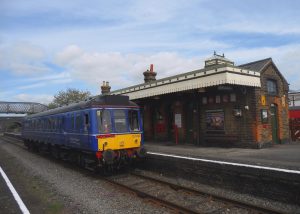A Picturesque Line In the South Of England
Nestled amidst the picturesque landscapes of southern England, the Chiltern Main Line stands as a testament to both engineering marvels and natural beauty. Stretching from London to Birmingham, this historic railway route has woven itself into the fabric of the region, connecting urban hubs with rural havens while offering travelers a glimpse into the past and present. Spanning approximately 112 miles, the Chiltern Main Line traverses a diverse range of landscapes, from bustling cityscapes to serene countryside vistas, making it a journey that’s as much about the destination as it is about the passage itself.
A Glimpse into History
The story of the Chiltern Main Line dates back to the 19th century when the railway boom was transforming the way people and goods moved across the country. The line, initially known as the Great Western and Great Central Joint Railway, was intended to connect London with the North of England. Its creation marked a significant achievement in the realm of railway engineering, cutting through challenging terrains, including the hilly Chiltern Hills, with a combination of viaducts, tunnels, and embankments.
The Chiltern Main Line’s historical significance extends beyond its engineering feats. It played a vital role in transporting troops and supplies during both World Wars, solidifying its place in the annals of British history. As times changed, so did the railway’s ownership and purpose, but its legacy as a lifeline of connectivity remained intact.
A Modern Marvel
Fast forward to the present day, and the Chiltern Main Line has undergone a transformation to meet the demands of modern travel. Operated by Chiltern Railways, the line offers a seamless blend of contemporary comfort and nostalgic charm. State-of-the-art trains equipped with modern amenities whisk passengers away at high speeds, making the journey not only efficient but also comfortable.
One of the standout features of the modern Chiltern Main Line is its dedication to sustainability. In an era where environmental consciousness is paramount, Chiltern Railways has taken initiatives to reduce its carbon footprint. From implementing energy-efficient technologies on trains to adopting greener practices in operations, the line sets an example for environmentally responsible rail travel.
Scenic Delights
What truly sets the Chiltern Main Line apart is the kaleidoscope of scenic delights it offers to those fortunate enough to be on board. Departing from London, the train swiftly leaves the urban sprawl behind, entering the heart of the Chiltern Hills. Passengers are treated to panoramic views of rolling hills, dense woodlands, and charming villages that seem frozen in time.
As the train glides through the countryside, it passes iconic landmarks such as the historic market town of High Wycombe and the enchanting Roald Dahl Museum, paying homage to the famed author who spun tales of wonder. Further along the journey, the line makes a majestic ascent over the Great Western Railway viaduct, providing passengers with breathtaking vistas that showcase the natural beauty of the region.
A Culinary and Cultural Journey
Traveling along the Chiltern Main Line isn’t just about visual treats; it’s a journey for the senses. As the train moves through Oxfordshire and Warwickshire, passengers have the opportunity to savor the local culinary delights that the region has to offer. From traditional country pubs serving hearty British fare to quaint tearooms offering delicate pastries, the journey is punctuated by gastronomic adventures.
The cultural tapestry woven along the Chiltern Main Line is equally captivating. The line connects towns and cities that boast a rich history of literature, art, and architecture. Passengers can explore the charming literary connections of Oxford, delve into the historical significance of Banbury, or marvel at the intricate stonework of Warwick Castle.
Preserving the Past, Envisioning the Future
In preserving the Chiltern Main Line’s historical significance while embracing modernity, the railway authorities have struck a delicate balance. Historical stations have been meticulously maintained, reflecting the architectural elegance of a bygone era. Yet, the line’s commitment to innovation shines through in its efficient scheduling, comfortable carriages, and dedication to sustainability.
Looking ahead, the Chiltern Main Line’s future remains promising. It continues to be a lifeline for commuters and travelers alike, offering an alternative to congested roads and a glimpse into the splendors of the British countryside. As technology advances and priorities shift, the line will likely evolve, but its core essence as a gateway to both history and nature will remain unchanged.
Final Thoughts
The Chiltern Main Line is more than just a railway; it’s a journey through time and beauty. From its humble beginnings as a feat of Victorian engineering to its modern role as a conduit of sustainable travel, the line encapsulates the spirit of progress while honoring its historical roots. As passengers traverse its tracks, they’re not merely going from one point to another; they’re embarking on a voyage that celebrates the past, embraces the present, and paves the way for an inspiring future.



1 comment
We would like to thank you again for the stunning ideas you gave Janet when preparing her
post-graduate research as well as, most importantly, pertaining to providing all the ideas within a blog post.
Provided we had been aware of your web site a year ago, we
will have been saved the nonessential measures we were implementing.
Thanks to you.